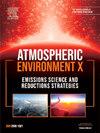土壤淹水增加了温室气体通量
IF 3.4
Q2 ENVIRONMENTAL SCIENCES
引用次数: 0
摘要
土壤洪水对土壤健康产生不利影响,对生计、农业和环境构成重大挑战。本研究调查了洪水、洪水持续时间和水源(海水和淡水)对南佛罗里达州克罗姆和比斯坎两种主要土壤类型温室气体通量的影响。试验采用淡水和海水分别浸渍Krome和Biscayne土壤,并在浸渍后第1、7、14和28天利用PVC箱采集温室气体样本。使用气相色谱仪分析样品的土壤二氧化碳(CO2)、氧化亚氮(N2O)和甲烷(CH4)通量。结果证实,CO2和N2O通量具有明显的变化规律,在淹水后1天达到峰值,随着淹水的进行急剧下降。土壤类型、洪水持续时间和水源是调节CO2和N2O通量的关键因素,但CH4通量始终低于检测限。与Krome相比,Biscayne土壤在海水和淡水淹没下的CO2和N2O通量最高。这些发现强调了洪水初始阶段在推动温室气体排放方面的关键作用,强调了制定有针对性的缓解战略的必要性。本文章由计算机程序翻译,如有差异,请以英文原文为准。

Soil flooding increases greenhouse gas fluxes
Soil flooding poses significant challenges to livelihoods, agriculture, and the environment by adversly affecting soil health. This study investigated the effects of flooding, flooding duration, and water source (seawater and freshwater) on greenhouse gas fluxes from two predominant soil types in South Florida—Krome and Biscayne. Experiments were conducted by flooding Krome and Biscayne soils with fresh and seawater, and greenhouse gas samples were collected using PVC chambers on the 1st, 7th, 14th, and 28th days of flooding. Samples were analyzed for soil carbon dioxide (CO2), nitrous oxide (N2O), and methane (CH4) fluxes using a gas chromatograph. Results confirmed that CO2 and N2O fluxes exhibited a distinct pattern, peaking one day after flooding and sharply decreasing with the progression of flooding. Soil type, flooding duration, and water source were critical factors modulating CO2 and N2O fluxes, but CH4 fluxes were consistently below the detection limit. Biscayne soil had the highest CO2 and N2O fluxes under seawater and freshwater flooding compared to Krome. These findings underscore the critical role of the initial flooding phase in driving greenhouse gas emissions, emphasizing the need for targeted mitigation strategies.
求助全文
通过发布文献求助,成功后即可免费获取论文全文。
去求助
来源期刊

Atmospheric Environment: X
Environmental Science-Environmental Science (all)
CiteScore
8.00
自引率
0.00%
发文量
47
审稿时长
12 weeks
 求助内容:
求助内容: 应助结果提醒方式:
应助结果提醒方式:


